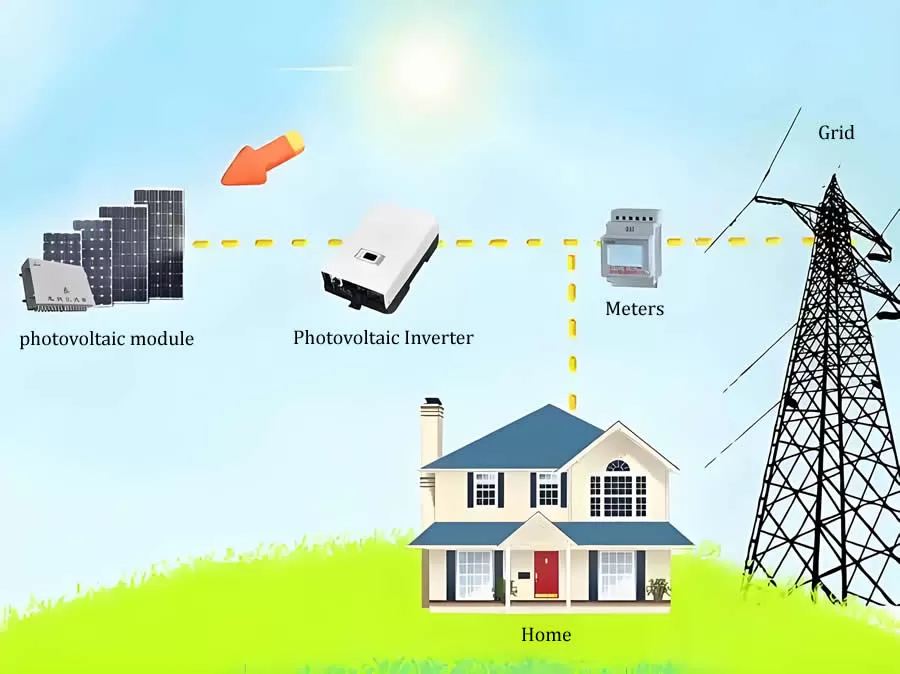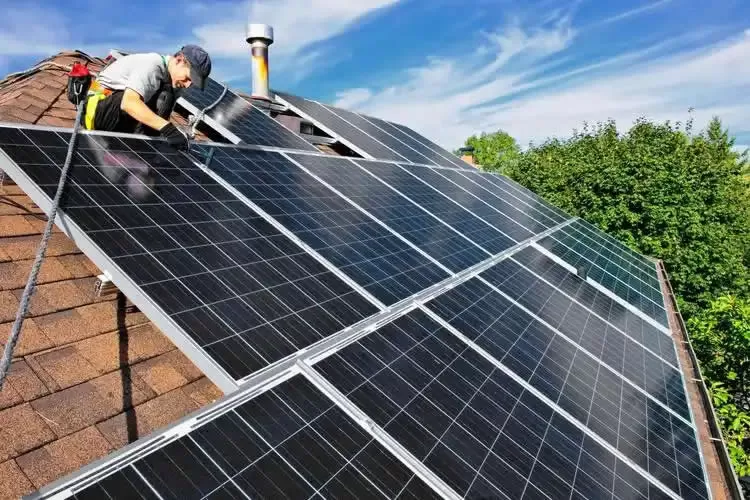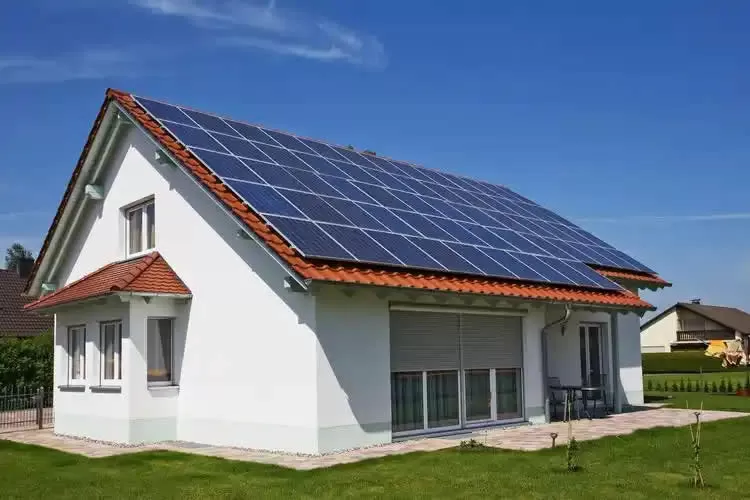
Home Solar Photovoltaic Design Ideas Diagram
As solar photovoltaic (PV) clean energy becomes more popular, more and more family homes are considering installing a PV power system to lower their electricity bills, reduce carbon emissions, and enhance electricity dependency. However, for families who are new to PV systems, the whole process from purchasing, installing and then using them, and even connecting them to the grid may seem complicated. Therefore, Brice Solar will introduce the installation process of home residential PV power generation system in detail to help you easily realize solar PV energy applications.
I. Basic Composition of Home PV Power Generation System
Home PV system is mainly composed of the following parts:
1. photovoltaic module (solar panel)
Converts solar energy into DC electricity, which is the core part of the whole system, using monocrystalline or polycrystalline silicon material, responsible for converting solar energy into DC electricity, the power generation efficiency is affected by the material, sunshine duration and installation angle.
2. Inverter
The inverter converts the DC power generated by the PV modules into AC power for home use or grid integration, and needs to match the power of the PV panels with intelligent optimization functions, such as Huawei's system to support independent adjustment of single panels to improve efficiency.
3. Racking and mounting equipment
The bracket needs to be adapted to the roof structure (flat/sloping roof) and ensure wind resistance. The cables are responsible for connecting the modules and ensuring stable current transmission, and are used for fixing the PV modules to ensure the optimal tilt angle and direction to improve power generation efficiency.
4. Energy storage battery (optional)
Used to store unused electricity during the day so that it can be used at night or during power outages. Li-ion battery storage systems can store excess electricity to realize nighttime power supply, but at a higher cost; most households choose the grid-connected mode to reduce the initial investment.
5. Electricity meter and grid-connected equipment (optional)
Monitor power input and output to ensure safe docking with the grid.
II. Site Selection Planning for PV System
The following key factors need to be considered when shopping for a PV power system for a family home type:
1. Roof area and orientation
The installation of PV panels requires sufficient light, and it is recommended that they be installed towards the south, with a moderate inclination angle, in order to obtain the best power generation effect. Detached villas, self-built houses, townhouses and other houses with independent property rights have independent roofs; high-rise houses are usually not applicable due to load-bearing and grid-connection limitations.
2. System Capacity Requirements
Select the appropriate PV power generation capacity according to the daily electricity consumption of the family. For example, for a family that consumes about 20 kWh of electricity per day, it is recommended to install a system of about 5kW. Each 1kW installed capacity requires about 8-10 square meters of rooftop space, and a 10kW system requires 80-100 square meters.
3. PV Modules
Prefer brand modules with high conversion efficiency and low attenuation rate to ensure long-term stable operation. Monocrystalline silicon has higher efficiency, usually more than 22%, but the cost is about 20% higher than that of polycrystalline silicon; used polycrystalline silicon panels have outstanding price/performance ratio, which is suitable for families with limited budget.
4. Inverter matching
The quality of the inverter directly affects the power generation efficiency of the system, you need to choose reliable products and ensure that the power is matched with the PV module, give priority to brands with L4-level arc protection, intelligent monitoring functions, such as Huawei program supports the mixed use of new and old batteries, reducing operation and maintenance costs.
5. The need for energy storage batteries
If the local government supports the “self-generation and self-consumption, residual power on-grid” model, it may not install energy storage batteries; if it wishes to improve energy independence or has emergency power, it may consider configuring an energy storage system.

Home roof is installing photovoltaic panels
Ⅲ.Installation process
1. Program design
Before the formal installation, a professional solar PV company needs to conduct a site survey and develop an installation program based on the family's electricity demand, roof conditions, local policies and other factors. In some areas, it may be necessary to report to the power company and obtain a grid connection license.
2. Construction of PV equipment
Purchase PV modules, inverters, racking and other equipment according to the design plan, and have them installed by professional technicians. The construction process includes:
Assembling PV racking and fixing the modules;
Wiring to connect the modules to the inverter;
Installation of energy storage batteries (if any);
Connecting power meters and grid-connected equipment to ensure the safety of power transmission.
3. PV energy storage system testing
After the whole PV energy storage system is installed, the system needs to be tested, including:
Check whether the lines are connected properly;
Monitoring whether the power generated by the PV modules is up to standard;
Whether the working condition of the inverter is stable;
Ensuring that the grid-connection process with the grid meets safety standards.

Home Rooftop Solar Panel Installation Effect
Ⅳ.Grid connection and revenue mode
Once the PV system is installed, it is necessary to apply for grid connection from the local power company and complete the signing of relevant agreements. The revenue model of a home PV system generally includes:
Self-generation and self-consumption
Prioritize the use of PV electricity to reduce the cost of purchasing electricity from the grid.
Feed-in of surplus electricity to the grid
Sell excess power to the grid for tariff revenue, suitable for households with high power consumption during the day, with revenue coming from tariff savings + surplus power sales, with a higher overall rate of return.
Peak and valley tariff optimization
Cooperate with the energy storage system, store electricity when the electricity price is low and use it during peak hours to further reduce the cost of electricity.
V. Maintenance of PV equipment
The daily maintenance of the family PV system is relatively simple, mainly including:
Regular cleaning of PV panels
Remove dust, leaves and other obstructions to maintain power generation efficiency, clean the surface dust of PV panels every quarter, and pay attention to checking the firmness of the bracket during the rainy season; the inverter needs to be kept ventilated to avoid high-temperature environments.
Monitoring system operation status
Regularly check the data of inverter and meter to ensure normal power generation of the system, real-time monitoring of power generation, energy storage status and equipment health through APP, and automatic alarm for abnormal conditions.
Check the power lines and connectors
Avoid aging or loosening to affect safety.
VI. Common Problems and Solutions:
Generation lower than expected
It may be caused by shadow shading, aging of components or accumulation of dust, and the specific reasons need to be investigated.
Inverter failure
If the inverter alarm or abnormal power failure occurs, the manufacturer or installation company should be contacted for repair.
Excessive loss of energy storage battery
It may be caused by too high charging and discharging frequency or temperature influence, it is recommended to optimize the use strategy.
Conclusion
Family residential class of photovoltaic power generation system can not only effectively reduce electricity costs, but also promote the use of green energy, but also a long-term income-type investment, to achieve a win-win situation for environmental protection and economic benefits. Through scientific site selection, reasonable equipment selection and optimization of grid connection strategy, users can significantly reduce electricity costs and enhance energy autonomy. We hope that this guide will help you successfully complete the purchase, installation and grid connection of solar PV systems, so that clean energy can bring long-term income and security for your family.
If you have any questions about PV system installation, please feel free to consult us to provide you with personalized solutions!









One step to find us,we will respond within 24 hours.
More Contact Details
008613738639386
[email protected]